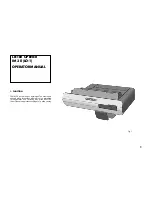
OPERATION
6
For initial connection, OSD Audio recommends selecting one speaker pair located closest to the room where you are operating
the SSVC6D. Select this speaker pair and turn on your receiver/amplifier. Make sure sound is coming from both speakers.
Before you turn on additional speakers, read the information below.
This Volume Control is a passive device (no power supply) that takes a signal from the source and allows you to attenuate or
turn the sound down. It does not add or increase the gain. Its main function is to provide impedance matching of your speakers
to the amplifier or receiver to which the SSVC6D is connected. This is especially important when playing more than two pair of
speakers at once. Each internal volume control has impedance jumpers that allow users to select 1X, 2X, 4X or 8X. These
settings correspond to the number of speaker pairs you will be adding to each zone and should be adjusted accordingly. The
default is 4X for each. Changing the settings involves removing the cover of the Speaker Selector. If you have a question
regarding changing these jumper settings you should first call our tech support at OSD Audio to walk you through the procedure.
Level Controls: Turning the level control fully counterclockwise will reduce the level of sound to fully muted. Turning the level
control clockwise will increase the volume in approximately 3 dB to 6 dB increments (depending on which of the 12 steps for a
total of 54dB). Note: Even though there is no sound coming out of the speakers when turned fully counterclockwise, the Volume
Control is still engaged and drawing signal to its transformers. OSD Audio recommends using the on/off switch for the respec-
tive zone to fully turn the Volume Control off
Note: Refer to your amplifier or receiver’s user manual or on the rear panel of the unit to determine the minimal speaker imped-
ance that your amplifier can handle.
























